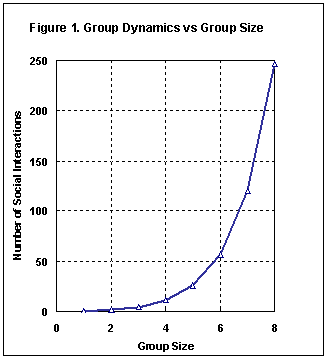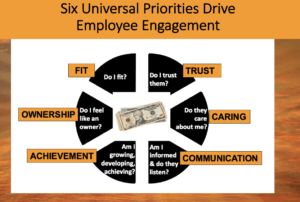So what is the optimal size for effective decision-making? Much of work today is done in teams. Even in MBA programs, the team is the structure used to meet class goals.
A Harvard Business Review stat published research by Marcia W. Blenko, Michael C. Mankins, and Paul Rogers. It indicates that seven (7) is the optimal size. Yet much of the research I’ve found says that number is a bit too high.
First, many studies target an “odd” number as the first criteria for group size. According to one resource:
This (an odd number) prevents ties and improves the odds of making a correct decision when using majority rules.
Even-numbered groups can make decisions, but the decision-making can take more time.
Importance of social sensitivity of group members
Getting back to the actual number, think about the benefits of a large group. The more people you have, theoretically, the better chance you have of getting the best information to make the best decision. Research has shown that collective intelligence does exist. But, according to research reported in Science, the October 2010 issue by authors Anita Williams Woolley, Christopher F. Chabris, Alex Pentland, Nada Hashmi and Thomas W. Malone:
This “c factor” (the group’s collective intelligence) is not strongly correlated with the average or maximum individual intelligence of group members but is correlated with the average social sensitivity of group members, the equality in distribution of conversational turn-taking, and the proportion of females in the group.
So it looks like social sensitivity–possibly a more common attribute to females–facilitates group decision-making. Emotional intelligence and what some consider the soft stuff is important to the functioning of teams.
So getting back to the optimal group size–what’s the best number? In what size, can you have the equality in distribution of conversation turn-taking as the research indicates is an important feature of an effective group?
If you measure the number of possible social interactions with varying group sizes, the optimal group size appears to be five (5). According to a resource on applications of probability and statistics:
As can be seen by the figure below, the number of possible social interactions begins to explode in groups with more than 5 people.
Optimal group size study: Hackman and Vidmar
Research by Hackman and Vidmar (1970) on optimum group size for member satisfaction showed a similar outcome. They composed groups that ranged in size from 2-7 members to assess the impact of size on group process and performance for various kinds of tasks.
After the groups had finished their work, they asked participants independently to indicate the extent of their agreement with the following two questions: Question #1- This group was too small for best results on the task it was trying to do. Question #2- This group was too large for best results on the task it was trying to do.
The chart below indicates the average answers to these two questions on the same graph. Not surprisingly, few people in the dyad thought it was too large and few in the 7-person group thought it was too small. What is noteworthy is where the two lines crossed. They dropped a perpendicular line from that point to the horizontal axis and discovered that the optimum group size was 4.6 members.
Consider effects of size on counterproductive behaviors
Aube, Rousseau, and Tremblay published a study in 2011 in Group Dynamics: Theory, Research, and Practice. They focused on the relationship between size of the group and the quality of the experience. They examined the mediating effects of counterproductive behaviors. The results support a negative relationship between size and the quality of the experience. To sum up, their research supports managing the size of a team.
Overall, the results of this study provide evidence that the more members there are in a team, the more likely the team is to encounter problems with its functioning and its outcomes
Keep in mind that one individual’s bad behavior can negatively impact the team.
Consider the engagement of team members
 Effective size alone is not sufficient in creating winning teams. Success depends on engaging the members of the team so they put forth their energy toward accomplishing team goals. Learn more about employee engagement, the drivers of engagement, and how to survey employees for engagement. Build a team where members thrive.
Effective size alone is not sufficient in creating winning teams. Success depends on engaging the members of the team so they put forth their energy toward accomplishing team goals. Learn more about employee engagement, the drivers of engagement, and how to survey employees for engagement. Build a team where members thrive.
One-on-one meetings held in-person or virtually also promote team member engagement. Discover the questions to ask when meeting with each individual on your team.
Ensure effective meeting management
Additionally, the group must be skilled in effective meeting management. Even with a small group, employees must think through the purpose of meeting, the outcomes desired, and the agenda. And of course, meeting action plans must be formalized to ensure progress. For more information on how to run an effective meeting, contact Sheila.
Summary
So if you’re looking for the best size for a team, consider an odd number close to five. But remember the number is just one factor. And the task of the team can influence size.
Additionally, social sensitivity, being able to read emotions, and other behaviors that promote engagement are attributes of successful team decision making.
Consider the number, the task, and the members. Maybe they’ll need training in engagement. Sounds like the right-sized team that practices many of the principles of employee engagement can be the most effective path.
Contact Sheila
Contact Sheila for information on her organizational culture, change, and employee engagement services. She also provides training in effective meeting management. Her management consulting firm Workplace Culture Institute is based in Atlanta, serving clients globally.
Use the Contact Form to email Sheila.
Pawel Brodzinski Posted on 6:11 am - January 23, 2014
Hi Sheila,
Interestingly enough Anita Woolley in her research also mentions that collective intelligence grows as a team size increases and it flattens out between 10 and 11 people. It means that from a perspective of solving complex problems or accomplishing complex tasks the additional power we get by adding further team members compensates for the cost of more communication path and social interactions. It goes way beyond 5 people.
I often ask people during my presentations about an opinion whether individual intelligence and collective intelligence are connected. I always get vast majority of answers pointing that there is such connection, a discussion is only how strong it is. As you surely know the research didn’t prove it to be true. This is, by the way, a challenge of research based on opinions–the conclusions should be drawn very carefully.
By the way an interesting area to focus on would be what happens in big teams, e.g. bigger than 10 people. From my experience the team dynamics changes a lot. People tend to create sub-groups but often these sub-groups are created and disbanded dynamically depending on a situation. This at least partially addresses the challenge of too many social interactions and communication complexity. In other words at the same time a person can operate in a small group and a bigger entity. What would be the team size exactly in such a case?
Guest Posted on 4:29 am - February 4, 2016
The size of the group is not the only problem.
Another problem, for example, may be what is the optimal kind of experts that are to be engaged in a particular task.
Depending on what experts one chooses in the decision making process they may twist or distort the decision in one direction or another.
If you can manipulate, however the decision by the choice of the types of experts, what is the idea to letting them making the decision – why don’t you take personally the decision? … and it is not funny.
Leave a Reply
Cancel reply
Leave a Reply
This site uses Akismet to reduce spam. Learn how your comment data is processed.



6 Comments